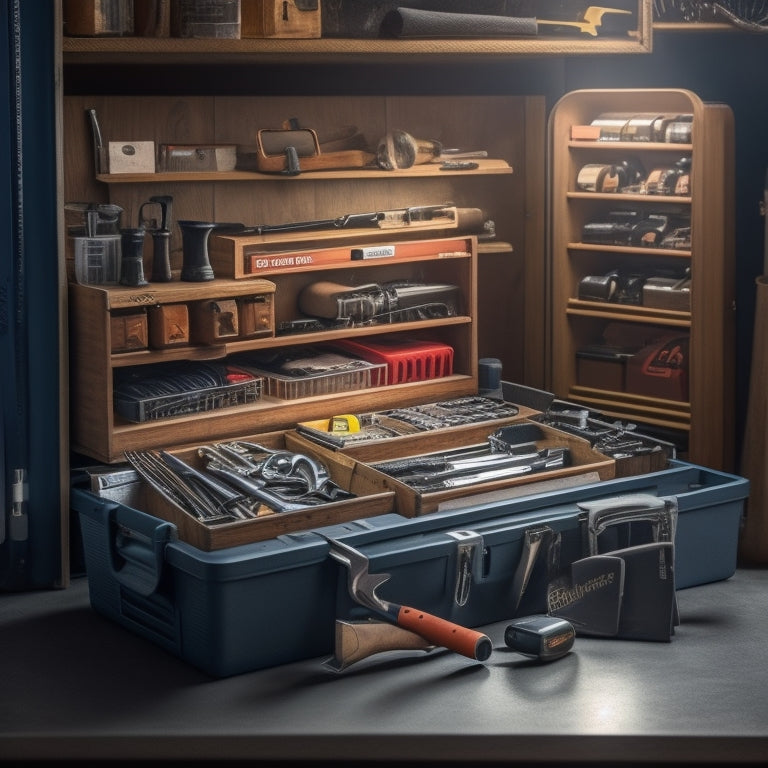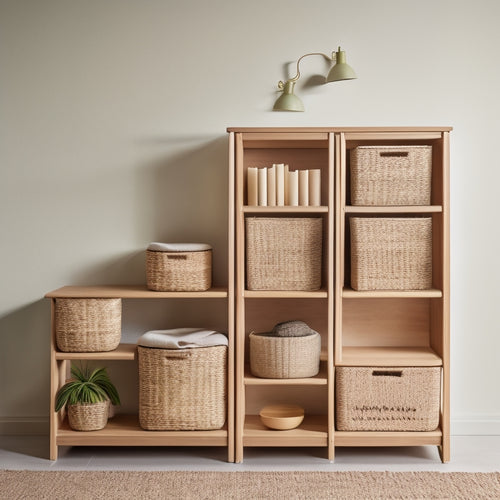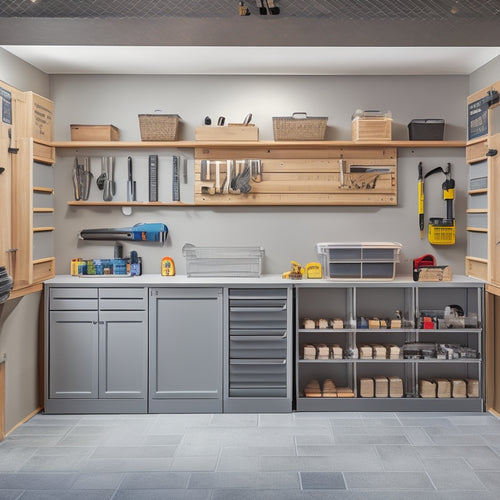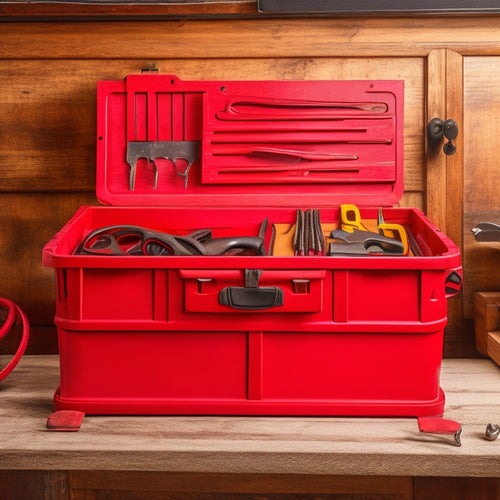
The Ultimate Tool Box Organization System
Share
You're one misplaced wrench away from a productivity-killing mess, but with a well-designed tool box organization system, you can tame the chaos and get back to work. By categorizing tools by type, project, or task, and utilizing portable storage solutions like tool chests and cabinets, you'll be well on your way to maximizing efficiency. Essential tool storage ideas, such as shelf storage and pegboard solutions, will help prioritize your most-used tools. Customizing your tool box with dividers, labels, and color-coding will streamline your workflow, and maintaining organization with regular clean-ups and inventory checks will keep your tools - and your sanity - intact, and that's just the beginning of your expedition to a clutter-free workspace.
Key Takeaways
- Categorize tools by type, project, or frequency of use to create a logical and efficient storage system.
- Utilize a combination of shelf storage, pegboard solutions, and portable storage to maximize space and accessibility.
- Label and organize tools using clear, concise labels, dividers, and bins to ensure quick identification and retrieval.
- Customize the tool box layout to fit individual needs, including grouping similar tools together and color-coding labels.
- Establish a regular maintenance routine to ensure the tool box remains organized, clean, and clutter-free over time.
Tool Box Organization Methods
Five common tool box organization methods exist to help you optimize your tool storage space. You can choose the one that best fits your needs and preferences.
The first method involves categorizing tools by type, such as hand tools, power tools, and fasteners. This approach allows you to quickly locate the tool you need and prevents clutter from building up.
Another method is to organize tools by project, grouping tools used for specific tasks together. This approach is ideal for professionals who work on multiple projects simultaneously.
You can also use portable storage solutions, such as tool chests and cabinets, to keep your tools organized and within reach. Labeling each compartment or drawer helps you quickly identify where each tool is stored.
Additionally, you can use dividers or bins to separate small parts and accessories, keeping them from getting lost or damaged.
Essential Tool Storage Ideas
Since a well-organized tool box is crucial to maximizing productivity and efficiency, it's important to incorporate key tool storage ideas into your system. You'll want to guarantee that frequently used tools are easily accessible, while less frequently used tools are stored in a way that saves space.
Shelf storage is an effective way to keep tools organized, allowing you to categorize and prioritize your tools. Labeling each shelf will help you quickly identify where each tool is stored.
Pegboard solutions are another key tool storage idea. By hanging your most frequently used tools on a pegboard, you'll be able to grab them quickly and easily. This will save you time and reduce frustration.
You can customize your pegboard to fit your specific needs, using hooks, bins, and holders to store a variety of tools. Additionally, consider using dividers to separate tools on your pegboard, keeping them organized and preventing them from getting jumbled.
Maximizing Tool Box Space
Now that you've categorized and prioritized your tools using shelf storage and pegboard solutions, it's time to focus on maximizing the space within your tool box.
Efficiently utilizing the available space guarantees you can store more tools, reduce clutter, and maintain a safe working environment.
Implement space-saving techniques by installing dividers or compartments within your tool box. This segregation enables you to allocate specific areas for frequently used tools, lessening the need to dig through the entire box.
Consider vertical storage options, such as stackable trays or drawers, to optimize the tool box's vertical space. This allows you to store more tools while maintaining easy access.
Label each compartment and tray to facilitate quick identification and retrieval of tools. This organization system also helps prevent tools from getting damaged or lost.
Customizing Your Tool Box
Every well-organized tool box deserves a personalized touch. As you've maximized your tool box space, it's time to customize it to fit your specific needs. This involves implementing tool selection strategies that prioritize the tools you use most frequently.
Start by grouping similar tools together, such as all your wrenches or pliers, and allocate a designated area for each group. This will allow you to quickly locate the tool you need, reducing downtime and increasing productivity.
Effective tool labeling techniques are also essential in customizing your tool box. Use clear and concise labels to identify each tool, and consider color-coding labels to categorize tools by type or function. This will prevent confusion and guarantee that you're using the correct tool for the job, reducing the risk of accidents and errors.
Additionally, consider adding an inventory list or a tool tracker to keep track of your tools and prevent loss or misplacement. By customizing your tool box, you'll be able to work more efficiently, reduce stress, and maintain a safe working environment.
Maintaining Organization Over Time
You've optimized your tool box's space and customized its layout to fit your needs, but your work isn't done yet. Maintaining organization over time requires routine maintenance and adopting good organization habits. Set aside time each week to tidy up your tool box, ensuring everything is in its designated place. This will prevent clutter from building up and reduce the risk of accidents caused by misplaced tools.
| Task | Frequency |
|---|---|
| Clean and dust tool box | Weekly |
| Check tool inventory and restock as needed | Monthly |
| Reorganize tool box layout as needed | Quarterly |
Frequently Asked Questions
Can I Use a Tool Box Organization System for My Small Workshop?
You can optimize your small workshop's layout by implementing a tool box organization system, ensuring efficient tool storage and reducing hazards, allowing you to work safely and effectively, and saving time searching for misplaced tools.
Are There Any Eco-Friendly Tool Box Organization Materials Available?
You're searching for eco-friendly tool box organization materials like a detective hunting for clues, and luckily, you'll find plenty of options made from recycled materials that offer sustainable storage solutions, ensuring your workshop is both organized and environmentally responsible.
How Do I Keep My Tool Box Smelling Fresh and Clean?
You'll prevent foul odors in your tool box by implementing tool maintenance tips like regular cleaning and drying, odor elimination techniques such as baking soda or activated charcoal, and storing tools in well-ventilated areas to keep them fresh and clean.
Can I Use a Tool Box Organization System for My Portable Tools?
You can optimize portable tool storage using dividers, compartments, and labels, ensuring tool accessibility with these tips: store heavy tools at the bottom, frequently used tools upfront, and keep similar tools together for efficient retrieval.
Are There Any Tool Box Organization Systems Designed for Left-Handed Users?
You're likely wondering if tool box organizers cater to your unique needs as a left-handed user. Yes, some systems feature left-handed layouts with customized compartments, ensuring your tools are within easy reach, reducing confusion and increasing workplace safety.
Conclusion
Now you're the expert of your domain, with tools at your fingertips and a sense of control that's hard to match. Chaos has given way to precision, and the sweet scent of organization wafts through the air. Your tool box, once a jumbled mess, has metamorphosed into a sleek, high-performance machine, where every second counts and every tool has its place. Efficiency has never felt so good.
Related Posts
-

Open Storage Bins for Shelving Units
You need open storage bins that integrate seamlessly with your shelving units to boost your organization, productivit...
-

Essential Steps for Garage Storage System Design
You're about to change your cluttered garage into an organized haven by following a structured approach to garage sto...
-

Portable Tool Chest Essentials
When stocking your portable tool chest, you'll want to prioritize essential hand tools like hammers, tape measures, a...


